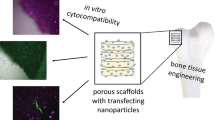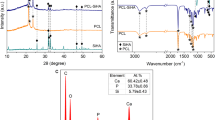Abstract
The results of studies into microporous scaffolds based on polycaprolactone, in particular, involving nanoparticles and microparticles of modified (silicon-containing) hydroxyapatite (hybrid scaffolds) are presented. When hydroxyapatite particles are used during the electrospinning of polymer scaffolds, their porosity is found to increase substantially and a structure with nanofibers and microfibers can be created. X-ray phase analysis demonstrates that the characteristic lines of polycaprolactone and hydroxyapatite exist in the 3D hybrid scaffold structure. According to the data of infrared (IR) spectroscopy of the hydroxyapatitepowder precursor, (SiO4)4– ions are embedded in its lattice. The results of studies into the surface wettability indicate that the contact angles of wetting with water are smaller for hybrid scaffolds than for pure polycaprolactone scaffolds. Adhesive and proliferative activity tests of human mesenchymal stem cells (MSCs) performed upon hybrid-scaffold cultivation on the surface, as well as histologic investigations, indicate the high biocompatibility of the samples. On the basis of a polymerase chain reaction, it is revealed that the differentiation of MSCs occurs in the osteogenic direction. On account of a porous structure, hybrid scaffolds can be employed to recover bone-tissue defects.
Similar content being viewed by others
References
M. Hakkarainen, Degradable Aliphatic Polyesters (Springer, Berlin, Heidelberg, 2002), p.113.
A. Gloria, F. Causa, T. Russo, et al., Biomacromolecules 13 (11), 3510 (2012).
G. Tetteh, A. S. Khan, R. M. Delaine-Smith, et al., J. Mech. Behav. Biomed. Mater. 39, 95 (2014).
J. Arends and W. L. Jongebloed, Caries Res. 11 (3), 186 (1977).
M. Mastrogiacomo, A. Corsi, E. Francioso, et al., Tissue Eng. 12 (5), 1261 (2006).
M. Ding, A. Odgaard, F. Linde, et al., J. Orthop. Res. 20 (3), 615 (2002).
S. Kedem, J. Schmidt, Y. Paz, et al., Langmuir 21 (12), 5600 (2005).
X. L. Deng, G. Sui, M. L. Zhao, et al., J. Biomater. Sci., Polym. Ed. 18 (1), 117 (2007).
V. Thomas, S. Jagani, K. Johnson, et al., J. Nanosci. Nanotechnol. 6 (2), 487 (2006).
F. Yang, S. K. Both, X. Yang, et al., Acta Biomater. 5 (9), 3295 (2009).
A. G. Mikos, G. Sarakinos, M. D. Lyman, et al., Biotechnol. Bioeng. 42 (6), 716 (1993).
H. Bittiger, R. H. Marchessault, and W. D. Niegisch, Acta Crystallogr., Sect. B: Struct. Crystallogr. Cryst. Chem. 26 (12), 1923 (1970).
H. Miraoui and P. J. Marie, Gene 468 (1–2), 1 (2010).
S. P. Grogan, T. Olee, K. Hiraoka, et al., Arthritis Rheum. 58 (9), 2754 (2008).
J. Xu, Z. Li, Y. Hou, et al., Am. J. Transl. Res. 7 (12), 2527 (2015).
A. Augello and C. De Bari, Hum. Gene Ther. 21 (10), 1226 (2010).
M. Bruderer, R. G. Richards, M. Alini, et al., Eur. Cells Mater. 28, 269 (2014).
Author information
Authors and Affiliations
Corresponding author
Additional information
Original Russian Text © S.N. Gorodzha, M.A. Surmeneva, I.I. Selezneva, A.M. Ermakov, V.V. Zaitsev, R.A. Surmenev, 2018, published in Poverkhnost’, 2018, No. 7, pp. 92–102.
Rights and permissions
About this article
Cite this article
Gorodzha, S.N., Surmeneva, M.A., Selezneva, I.I. et al. Investigation of the Morphology and Structure of Porous Hybrid 3D Scaffolds Based on Polycaprolactone Involving Silicate-Containing Hydroxyapatite. J. Surf. Investig. 12, 717–726 (2018). https://doi.org/10.1134/S1027451018040092
Received:
Published:
Issue Date:
DOI: https://doi.org/10.1134/S1027451018040092




